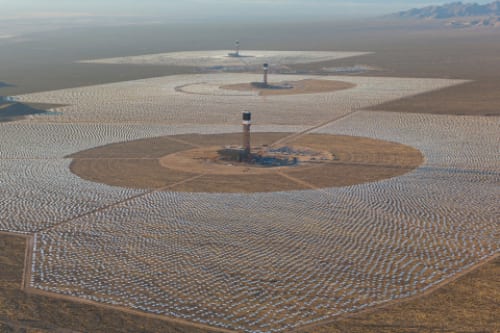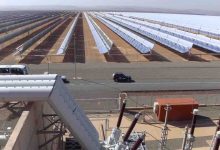Australia could shave as much as $10 billion off the cost of the transition to a renewable grid by investing, now, in the development of very long duration energy storage technologies like concentrated solar thermal, a new report has claimed.
The report, The Australian Concentrating Solar Thermal Value Proposition, argues that if decisions about the National Electricity Market (NEM) were purely made on cost grounds, concentrated solar thermal technology (CST) would own a 5.6 gigawatt (GW) piece of the network by 2050.
But Australian Solar Thermal Research Institute (ASTRI) director Dominic Zaal says it’s unlikely very long duration energy storage technologies like CST will be on the radar as a broad investment option until there is “enough pain in the system.”
The report was commissioned to look at how the technology might evolve in Australia, if the country began considering long-term electricity storage today rather than in a decade’s time, Zaal says.
“The biggest challenge facing countries like Australia is this conundrum around companies, governments, ministers all focusing on the 2030 target.
“CST as a technology is not about 2030 it’s about how to get to net zero by 2040, 2050. It’s all around long duration, intraday storage that gives you 10-15 hours of power overnight,” he told RenewEconomy.
“The issue is at night people are putting in battery projects with only two hours storage capacity and nothing longer term yet, because Australia is blessed with coal and gas.”
Could save $10 billion
The report says Australia could avoid as much as $10 billion in extra costs by 2050 if it begins to consider long term storage now, and specifically CST.
Those extra costs come from not needing to build extra photovoltaic solar capacity backed by shorter-term lithium-ion batteries into the grid, as well as opening up currently curtailed capacity in weaker parts of the grid. The report also assumes a falling lifetime cost as initial upfront costs are averaged out over more years and rising lifetime value as those costs fall.
The comparison was between building 5.6GW of CST between 2030 and 2050 into the grid, and instead installing only large scale and rooftop photovoltaic solar, and wind, backed by batteries, pumped hydro or hydrogen, and geothermal and biomass options.
The report did not consider alternative technologies such as flow batteries, adherents of which also say their time is coming as a long-term storage option and have had a presence in the Australian market for at least a decade.
Perfect for Australia?
CST is a technology that got its start in 1984 and today, according to the report The Australian Concentrating Solar Thermal Value Proposition, has 100 examples around the world producing 7GW of power.
The largest to date is the Noor Energy 1 project in Dubai with a total CST capacity of 700 MW and storage capacities of up to 15 hours.
In Australia, Vast Solar has a 1.1 MW pilot plant but is reviving an older project at Port Augusta Vast into a 30MW / 288 MWh concentrated solar thermal power plant. in Mildura, Raygen Resources combines 4MW of high efficiency photovoltaic solar and 2.8MW / 50MWh of long duration storage, and while it uses the same concept as CST, it achieves the same outcome with different storage technology.
CST technology uses different types of reflective surfaces to concentrate the sun’s rays to a small area to generate medium to high temperature heat (from 150°C up to 1,000°C. The generated heat can be used immediately or stored for multiple hours or even days. The heat can be used directly in industrial processes, to drive a turbine to make more electricity, or to drive chemical processes.
The downsides are there are a lot of moving parts to maintain and monitor and the salt has to be kept above about 250°C at all times, or it freezes.
CST was supposed to be the perfect technology for Australia, but it was beaten by the rapidly falling cost of photovoltaics and then the equally precipitous decline in the cost of lithium-ion batteries.
The epic failure of US project Aurora, in Port Augusta, in 2019, after many promises, has also cast a long shadow over the technology in Australia.
However, Zaal and other long-duration adherents say lithium-ion can’t deliver the overnight storage Australia will increasingly require as it shifts into a more electricity-hungry country.
“Batteries are only cost effective for about 2-3 hours and after that you need something else,” he says. “That something else is going to be pumped hydro, hydrogen, or CST.”
Furthermore, he says the technology can be derisked: most of the operational plants today use parabolic troughs rather than the ‘tower of power’ (image below), meaning it’s a proven technology and could be installed relatively easily using existing international experience as a guide.

Expensive upfront costs
The report, by German consulting firm Fichtner, estimates a 140 MWc CST plant with 14 hours of storage today in Australia would cost $915 million, or $6535/kW, based on current upfront costs for plants overseas and other factors such as supply chain inflation.
In comparison, the CSIRO Gencost report this year put pumped hydro with 12 hours of storage at $3304/kW – although actual projects show the sky is the limit for costs, such as Queensland’s 2GW, 24 hour (48GWh) Borumba pumped hydro station which has already hit $7000/kw.
At these prices, and given all of the high upfront costs need to be paid before any money comes in for a technology that is untried at scale in Australia, there needs to be policy-level backing for long duration storage to get CST off the ground.
The federal government has launched its capacity investment scheme, with NSW and Victoria the first states to launch auctions under the program, and Zaal says NSW and WA are looking hard at the long term industrial benefits that investing early in long duration stage might bring.
No one trick pony
CST could offer other benefits as well, the report suggested, as an alternative for remote and mining locations that need a lot of power and have big emission reduction targets.
Combining CST with solar PV and wind results in the lowest levelized cost of electricity (LCoE) for remote area power generation, the report said.
And the heat and power produced by CST can provide a base for producing different green fuels.
“For hydrogen production, the use of higher temperature Solid Oxide Electrolyser Cells (SOEC) explicitly profit from the use of CST for low-cost heat supply. This results in increased hydrogen production yields and a cost reduction of approximately 10 per cent,” the report said.
But the “sleeper” industry, as Zaal calls it, is in industrial process heating, and is an area where companies are already feeling the pain of high and variable gas prices.
On current CST construction costs, it’s competitive with gas prices above $16.7 /GJ ($60/MWh) and for renewable heat shares of up to 70-75 per cent.
Yesterday Zaal was walking the halls of the Mars pet food factory in Wodonga. The facility is already trialling a graphite battery, and ASTRI is helping it swap grid electricity to concentrated solar to charge it and also use the generated heat for its industrial processes.










